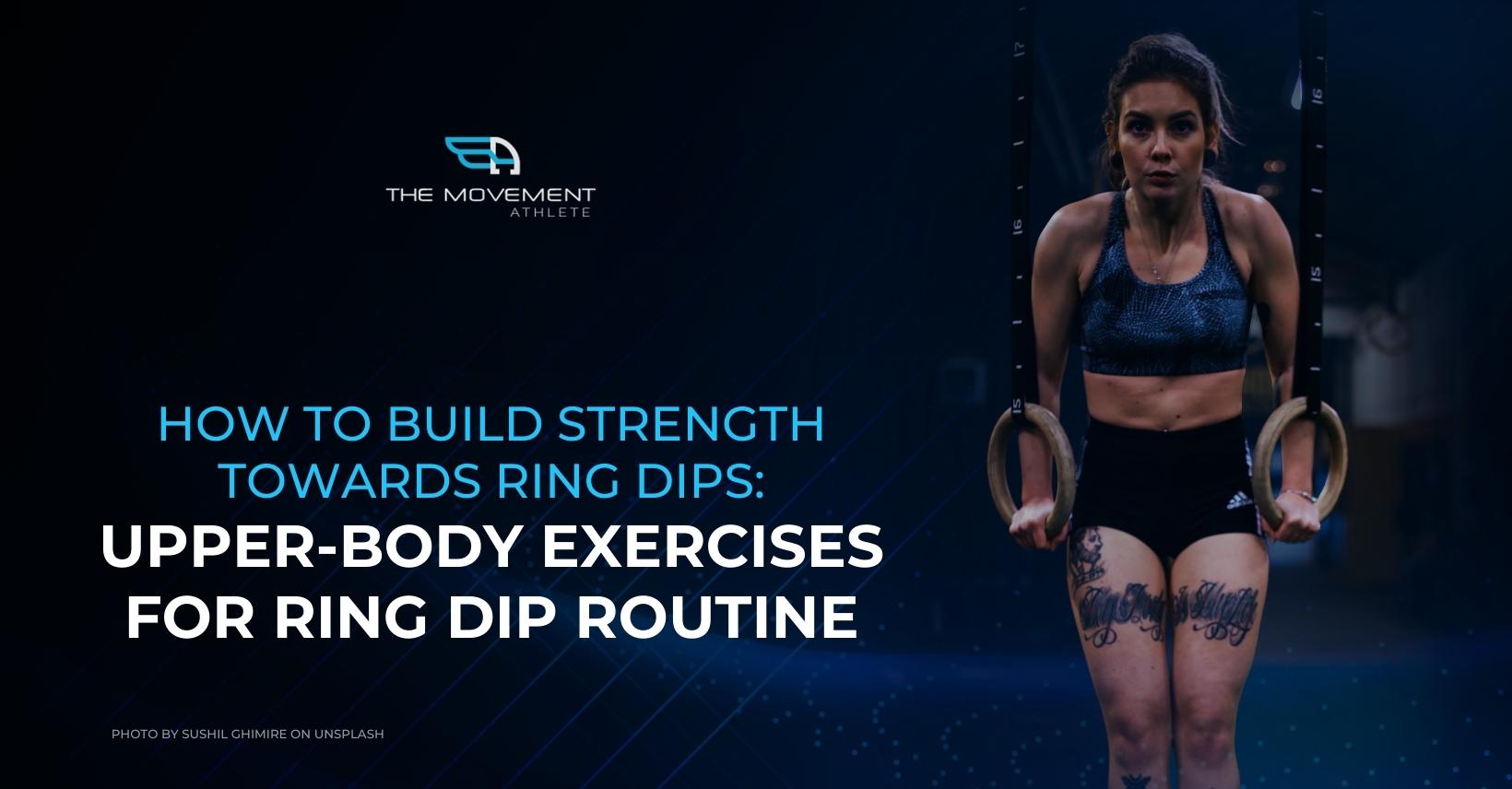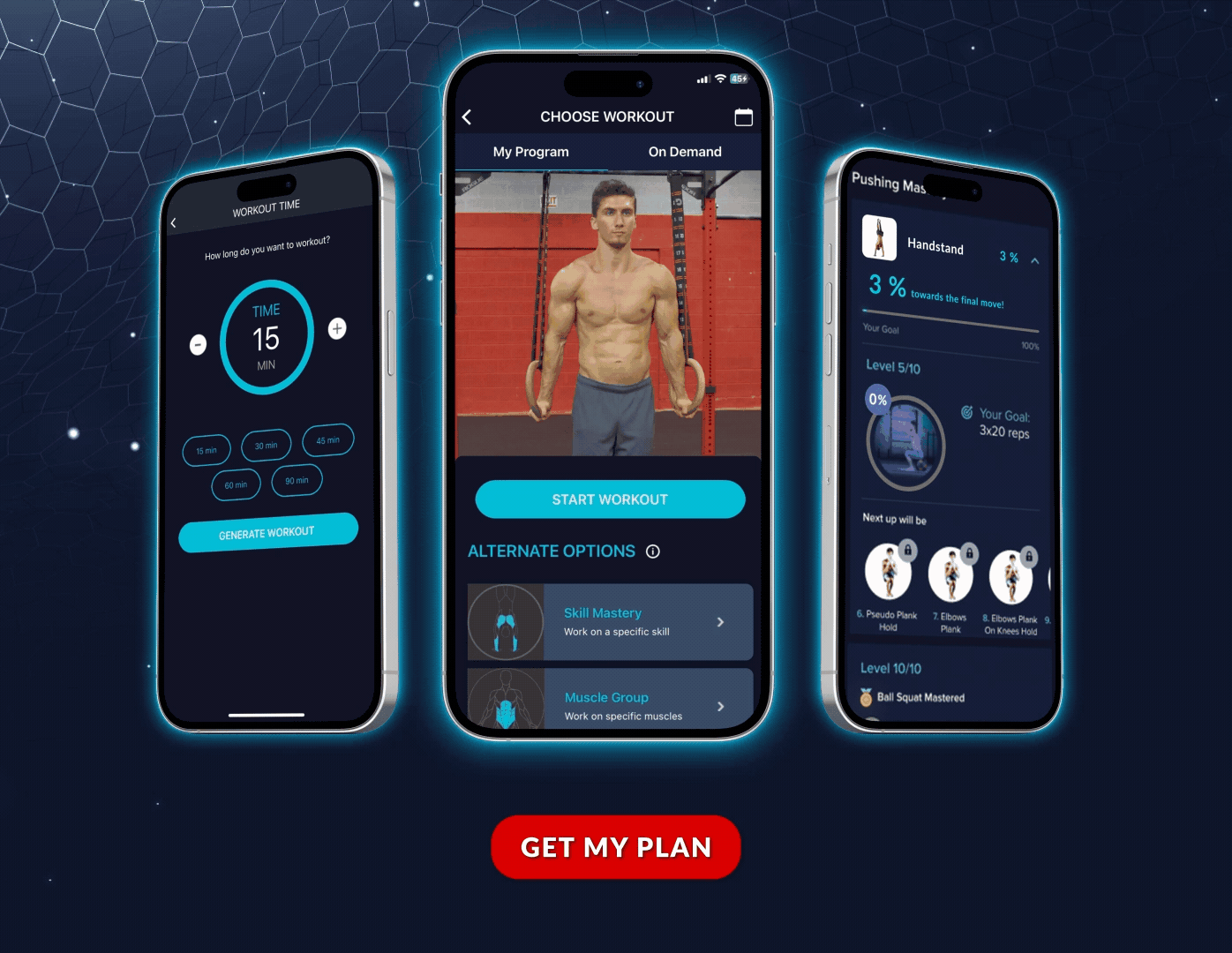

Ultimate Upper Body Ring Exercises: 6-Exercise Chest Building Routine
📖 Read Time: 12 Minutes | 🎯 Difficulty: Intermediate to Advanced | 💪 Focus: Ring Dips & Chest
🏆 Join 100,000+ Movement Athletes!
Ordinary people achieving extraordinary results with progressive calisthenics—no gym required!
✅ Master ring dips
✅ Build chest muscle
✅ Increase strength
Takes 5 minutes • Personalized to your level • No credit card required
📋 What You’ll Learn
- Why Rings: Perfect tool for building strong chest muscles
- Ring Benefits: Instability, balance, and strength transfer
- Workout Structure: 6-exercise circuit, 2x per week
- 6 Key Exercises: Step-by-step instructions with videos
- Expected Results: What to expect after 4 weeks
- Implementation: How to add this to your routine
✨ If you want to master ring dips, you need to directly train the exercise. There are no other shortcuts for it.
So your workout will include mobility exercises (7 Must-know Mobility drills) and the suitable ring dip progression (Best Ring dip progressions) for your current skill level.
😢 The Problem: Training with a limited set of exercises will not provide enough volume to optimize your muscular and strength potential.
So what can we do about it? 🤔
👊 We’ll add other exercises to supplement your ring dips training. In this article, we’re going to share with you a powerful chest-building routine that you can add after training your ring dip progression so you can master ring dips much faster!
🔎 Why Rings Are Perfect for Building Strong Chest Muscles
If you have been working on your ring dips, you should know by now the growth potential gymnastics rings can offer.
The stabilization required to even just do a support hold makes everything that you do on stable surfaces a lot harder. The difficulty increases by a huge margin that even if you have mastered dips on a stable surface, ring dips will feel like you added a ton of weight to the exercise (expect a lot of shaking when first trying the support hold).
🎯 How Rings Build Stronger Chest Muscles
✊ Fighting Instability
Everything on stable surfaces becomes A LOT HARDER on rings. Increased muscle recruitment and activation for even the simplest movements.
✊ Balanced Development
Arms work independently. Rings move separately, forcing stability for each arm. Minimizes muscle imbalances between sides.
✊ Strength Transfer
Being stronger on rings improves upper body strength everywhere else. Bench press, dips, push-ups become noticeably easier.
✊ Scalability
Easily adjust difficulty by changing ring height. Higher rings = easier (like incline), but still much harder than stable surfaces.
📌 Key Point: Adjust ring height according to your skill level so you can meet the volume requirements for the workout below.
📋 About This Workout
💪 Workout Structure
- Frequency: 2x per week
- Structure: Circuit of 6 exercises
- Rounds: 3 total rounds
- Rest between exercises: 0-20 seconds
- Rest after each round: 1-3 minutes
- Balance: Add 2 pulling days per week
⚡️ Why These Particular Exercises?
We need to add volume to the primary muscles involved when doing ring dips. These are also some of the all-time favorite pushing exercises because of their general transferability to many other movement patterns. You’ll feel the chest, shoulders, and arms burning from this workout.
⚡️ What Results Will You See?
Immediate: You’ll have a hard time lifting a bar of soap in the shower due to fatigue. This is a good thing. Your muscles are stretched and held in various planes on the rings.
Over 4 weeks: Expect larger chest, tricep, and shoulder muscles which will prepare you for better ring dips and increased bent and straight-arm strength.
🔥 Ring Dip Supplement Workout
Exercise #1: Ring Supinated Push-ups
🎯 Target reps: 12
The first movement is based on regular push-ups but with hands in a supinated grip at the top position. The change of grip is the key to more chest activation. It promotes the squeeze motion at the top position which requires additional stability from your chest making the exercise perfect for developing the pecs.
🎯 How to Perform:
- Set ring height appropriate for your skill level with rings shoulder-width apart
- Position hands on rings in false grip: grip rings with inner knuckles wrapping around
- Align body in straight line. Legs straight, feet together
- Turn out the rings outward at the top position
- As you lower down, turn to neutral position
- Lower until chest is leveled or lower than rings
- Push back up to starting position until rings turn out
- Repeat for reps
☑️ Coaching Pointers:
- Straight lockout arms at the top position after each rep
- Straight bodyline throughout movement
- Depressed shoulders, avoid shrugging
- Retracted scapula at bottom; protracted at top
- Elbows tucked close to body
- Ring turnout at the top position
Exercise #2: Archer Push-ups
🎯 Target reps: 12
Like other calisthenics fundamentals, unilateral work is a major asset to optimize muscle growth and fix muscular imbalances. Our focus is to create more muscle damage for each side so that your muscles can grow bigger and stronger. You can’t cheat your weaknesses here.
🎯 How to Perform:
- Set ring height appropriate for your skill level with rings shoulder-width apart
- Position hands on rings in false grip position
- Align body in straight line. Legs straight, feet together
- Turn out the rings outward at the top position
- Lower down to one side on one arm and push the supporting arm outward while keeping it straight
- Lower until chest is ring height
- Push back up to start position
- Do the same motion for the other arm
- Repeat for reps
Exercise #3: Wide Arm Push-ups
🎯 Target reps: 12
Let’s further isolate the chest muscles to add more volume to our training. The wider stance emphasizes your chest and since we’re doing it on rings, you can go deeper to stretch out the chest. The instability allows added difficulty while keeping your shoulders safe.
🎯 How to Perform:
- Set ring height according to your skill level
- Go into push-up position with ring turn-out at the top
- As you lower down, move your hands outwards while turning hands inward so back of hand faces forward
- Lower to 90 degrees
- Push back up to starting position
- Repeat for reps
Exercise #4: Rings “Ab Roller”
🎯 Target reps: 12
The chest, shoulders, and triceps play a major role in ring push work, but core strength is also needed for stability and global body tension. Ab rollers are one of the best core exercises you can do on rings.
The goal is to resist movement and resist the extension of your body by bracing your core. As a result, you get a stronger core which translates to stronger stability when doing dips or any other ring exercises.
🎯 How to Perform:
- Go into push-up position on rings with ring height adjusted to your skill level
- Move your hands forward while keeping them straight until arms are overhead
- Reverse the motion and repeat for reps
💡 Key: Maintain straight arm lockout and posterior pelvic tilt to focus ab activation. Don’t let the lower back arch!
Exercise #5: Crescents
🎯 Target reps: 12
Crescent flyes are an advanced fly variation that hits the chest in multiple planes because you’re not only opening your arms sideways, you’ll also move them around making a “crescent” shape with the rings. It’s basically an ab ring rollout plus chest flyes in one motion.
⚠️ Safety First: Control the full movement to avoid injury. Start with lighter load by doing it on knees or on an incline.
🎯 How to Perform:
- Begin in push-up position on rings
- Move your hands upward until arms are overhead
- Move arms sideways while keeping arms straight simulating crescent shape into lower flye position
- From here, pull hands together into push-up support hold
- Reverse the motion then repeat for reps
Exercise #6: Support Hold Forward Lean
🎯 Target hold: 12 seconds
Now we have placed emphasis on the core, triceps, and chest, it’s time to develop your anterior deltoids which are primary movers when doing ring dips. The forward lean from the support hold puts stress on the shoulders while adding tension to your straight arms.
🎯 How to Perform:
- Begin in push-up position on rings
- Turn your hands outwards until palms face forward while keeping arms straight
- Lean forward while keeping body position. Loading should be felt on anterior deltoids and biceps
- Hold the position for specified time
📋 To Summarize
👍 Training ring dips is of course the priority. You can do 3 sets of 8 reps of ring dip progression that suits your skill level. After that, you can supplement your ring dip journey with this upper body chest-building routine.
You can even do the workout as a general push-development exercise to partner with a pull routine.
🔥 Important: This workout is quite intense, so if you’re planning to implement this into your routine, be sure that you already have complete mastery of the calisthenics fundamentals.
If you’re unsure how solid your calisthenics fundamentals are, check out the assessment below 👇 so you can set a proper starting point in your calisthenics journey.
The only way you can move forward is knowing exactly where you’ll begin. 💪
📌 Key Takeaways
- Supplement, don’t replace – Do ring dip progressions first, then this routine
- Volume is key – Limited exercises won’t optimize your muscular potential
- Ring instability = gains – Harder than stable surfaces, better muscle recruitment
- 6-exercise circuit – Complete 3 rounds, 2x per week
- Fundamentals first – Master basics before attempting this intense routine
- Balance your training – Add 2 pulling days for complete development

🔥 Limited Time: Free Personalized Assessment ($197 Value)
Start Your Personalized Calisthenics Journey
Get Your Custom Training Plan Based on Your Current Level
⭐⭐⭐⭐⭐ Join 100,000+ athletes progressing from basics to advanced skills
✅ Complete movement assessment ($197 value)
✅ Personalized progression path ($297 value)
✅ Daily adaptive workouts ($47/month value)
✅ Ring dips when you’re ready ($297 value)
✅ Progress tracking system ($97 value)
🎆 Total Value: $935 – Yours FREE Today
🔒 100% Privacy Guaranteed • No Credit Card Required • Unsubscribe Anytime
💪 Real Member Success Story
“The Movement Athlete transformed my fitness journey. Started with basic push-ups, now I’m crushing ring workouts! The assessment showed me exactly where to begin – no guesswork, just progress. Best part? My shoulders feel stronger than ever, zero joint pain!”
— Sarah M., Software Engineer, Member since 2022
From zero pull-ups to muscle-ups in 18 months